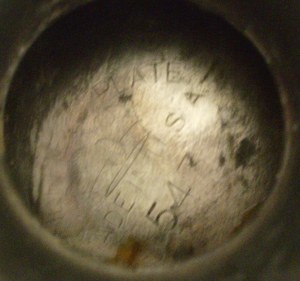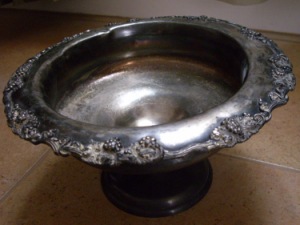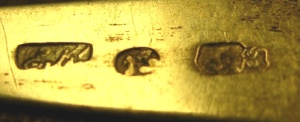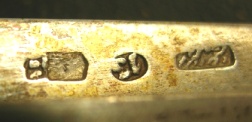 newsletter # 23 March 2006
newsletter # 23 March 2006www.ASCASonline.org
email: silverassociation@yahoo.it
Two new articles for ASCAS website
New membersWelcome to new ASCAS members: Lars Björkman - Sweden Gabriele Bonetto - Italy Vera Bradford - USA Charles C. Cage - USA Norma Cal - USA Juan Camos - Portugal Mary Clarke - South Africa Elizabeth A. Clough - USA Mark Daniels - England UK Mary Dostal - USA Emanuele Felicioni - Italy Alan Goldsmith - South Africa Suzanne Gouin - Canada Maureen Heenan - USA D.L. Irish - Australia Pat McCarthy - Canada Lucia McKay - USA John McTavish - Canada R. Milburn - England UK Willand Ringborg - Sweden Susan Urquhart - USA Ronald J. White - USA Members' Window # 23
Questions from ASCAS membersGiampiero Ierbulla writes: Both items were made in Italy, about 1930.
|
|
Nikica Vuletic receives this reply about his question
(February Newsletter) : |
Ellen Fuerst writes:
...I also have seen 'R_C' (it's not clear to me that the middle character is an 'E')
on some older Italian silver pieces. In each case, I have found that the item seems to be
related to either Cesa (Italian hallmark '1 AL') or Ricci, both of which are part of
Gruppo Greggio in Italy. I would suggest trying to contact Gruppo Greggio with a photo of
the piece and your question.
|
George Zochowski receives this reply about Egyptian marks
question
(February Newsletter) : |
Mark Mandel writes:
... in reply to George Zochowsky's query about Egyption silver references, I recommend
'International hallmarks on silver collected by Tardy'. The first mark shows the silver
fineness, which I believe to be 600/1000, the city of assay or manufacture is above this
mark, then the palm tree, which is the mark used after 1946 (prior to 1946, a cat was
used). Lastly, the arabic letter indicates the year (prior to 1946, the roman alphabet
was used).
|
Wayne Robbins receives this reply about his Samuel Pemberton question
(February Newsletter) : |
Geoffrey Axt writes:
... This is in response to Wayne Robbins' question in regard to his Samuel Pemberton
needle case.
The shape you question, namely, a cut corner rectangle or irregular octagon, was a shape
often favored by Pemberton in constructing small boxes and vinaigrettes (his specialty).
|
Cindy Sephton receives this reply about her silver plated fruit bowl
question
(February Newsletter) : |
Keeley Collins writes:
... Cindy wrote about a 'Sheffield Plate' bowl and wanted some info on the maker/age.
The mark pictured is not particularly helpful, but I may have found a reference to the
shield with a figure in it with vertical lines running through it.
Cindy, can you get a copy of 'Encyclopedia of American Silver Manufaturers' by
Dorothy Rainwater & Martin/Collette Fuller? You can find it in your local library,
or have them order it for you. There is a photo of a mark like the one you describe on
page 286. There is a shield with vertical lines and a Knight on a horse, with a 'K' in the
upper left corner. If this is the mark you see, it is ascribed to Mary C. Knight listed
as a metalworker with The Society of Arts and Crafts in Boston circa 1902-1927.
Sheffield Plate is named for the process in Sheffield, England, but if it is heavy, it
may be silver-on-copper (do you see some copper coloring coming through?). Silverplating
was in varying thicknesses and generally will wear off with cleaning over time.
Most modern articles recommend polishing once a year with a gently wash. If you love it,
it can be replated, but this is an expensive undertaking. Estes Silver in Atlanta Georgia
has the ability to do this, and to appraise your item.
Regards,
Keeley Collins
|
Rick Bakke receives this reply about his set of tea spoons
question
(February Newsletter) : |
Charls C. Cage writes:
... I recently applied for membership, so hope you will permit to share
with you some information on Rick Bakke's grandmother's spoons which appear in the
new February newsletter.
The city mark on these spoons is that of Karlsruhe, Germany,
and the maker EK is Ernst Kölitz, court goldsmith & perhaps the most prolific maker
in mid-19th century Karlsruhe.
Sincerely,
Charles C. Cage.
"A page per month"
in this new column we present a page (one page only) obtained by makers' brochures, books, auction catalogs or whatever other printed paper,
that may be of particular interest for ASCAS members.
The images will be published at a "low resolution" level and for private and personal use only
|
Calderoni centerpiece
|
Malinverni centerpiece
|
|
A S C O T T
ASCAS member David Shlosberg, the author of the book Eighteenth Century Silver Tea Tongs, has the intention
to set up a group for collectors of Tea Tongs to enable an exchange of knowledge and expertise between
those fortunate enough to own examples of these delightful artefacts.
The name of the new entity is ASCOTT (A Society for Collectors Of Tea Tongs).
More information about this new group are available on Dr. Shlosberg web site at
http://www.silverteatongs.com/index.php?f=data_home&a=2
A new web site
ASCAS member Raoul Verbist has created his new web site titled CHAMBRES DE MES AMIS (in French)
The address is www.chambresamis.org
Closing our March 2006 edition of ASCAS Newsletter I hope you have appreciated
its content.
Your comments, suggestions and advice will be of great
help.
My thanks to Geoffrey Axt (USA), Charles C. Cage (USA), John Chittenden (USA), Keeley Collins (USA), Ludo D'Haese (Belgium),
Jayne Dye (USA), Ellen Fuerst (USA), Candice Hern (USA), Giampiero Ierbulla (Italy), Mark Mandel (Canada),
Leslie Salvage (USA), David Shlosberg (UK), Raoul Verbist (Belgium), for their invaluable contributions.
Giorgio Busetto
Secretary
top page |
ASCAS is a community of people having a common interest in
antique silver.
|

































